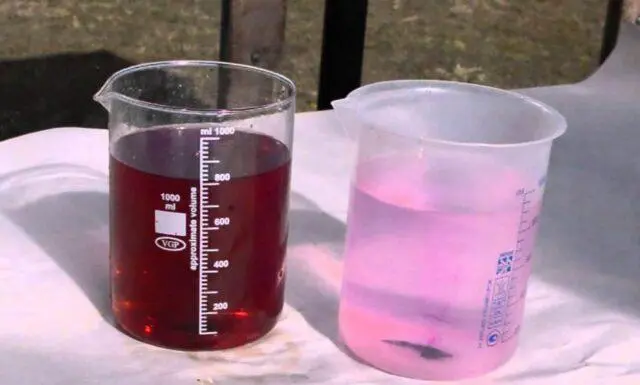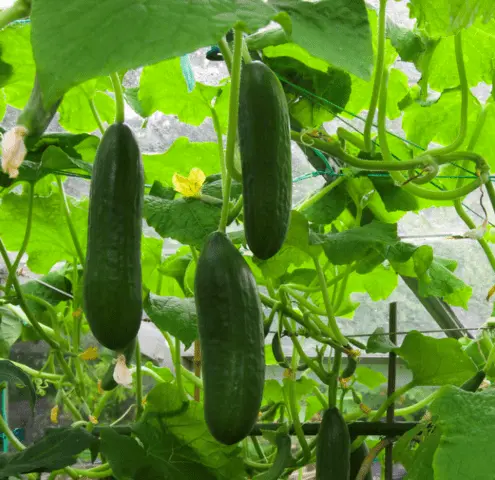Contents
- Why water cucumbers with potassium permanganate
- Features of the preparation of the solution
- Ways to use potassium permanganate for cucumbers
- Timing and frequency of treatments
- Features of the use of manganese for cucumbers in the greenhouse
- Safety measures
- Conclusion
- Reviews on the use of potassium permanganate for watering and spraying cucumbers
Watering cucumbers with potassium permanganate is done 2-3 times per season. This helps to saturate the soil with potassium and disinfects it from fungi, bacteria and other pathogens. The standard solution is prepared based on the ratio of 3 g per 10 liters of water. This is a safe concentration, which should not be violated. Otherwise, the leaves will get burned, and such treatment will do much more harm than good.
Why water cucumbers with potassium permanganate
Potassium permanganate is a dark purple crystals. Chemically it is potassium permanganate KMnO4. Due to this composition, the substance performs two important functions:
- Disinfection of the soil, destruction of spores of fungi, pathogenic bacteria and other microorganisms.
- Saturation of the soil with potassium – a vital element necessary for all plants.
The use of watering and spraying agents gives cucumbers great benefits:
- Prevention of dangerous fungal infections (powdery mildew, anthracnose, cladosporiosis, gray rot).
- Improving metabolism due to the intake of potassium.
- Ensuring normal growth and productivity.
- Protection of cucumber seeds from fungi, bacteria and other pests living in the soil.
Features of the preparation of the solution
Dilute manganese for spraying cucumbers in warm water. Cold liquid should not be used, as the crystals may not disperse. If they get on plants, leaves or stems will get severely burned and may even die.
The concentration depends on the purpose of the treatment:
- for dressing seeds – 10 g per 1 liter;
- for foliar treatment – 3 g per 10 l;
- for watering the soil before planting – 3 g per 10 l;
- for processing the walls of the greenhouse and the soil around it – 50 g per 10 liters.
Preparing the solution is quite simple. You need to act like this:
- Measure the required amount of powder.
- Dissolve in a small amount of warm water.
- Stir well.
- Bring to a total volume (1 l or 10 l).
- Mix again.
- Water the soil or pour it into a sprayer and process the cucumbers.

The solution used for processing should be a pale pink shade.
Ways to use potassium permanganate for cucumbers
Potassium permanganate is used for various purposes – seed dressing, root and foliar treatments. The concentration of the solution, as well as the timing and frequency of treatments depends on this.
seed Processing
To treat cucumber seeds, you need to prepare a 1% solution, i.e. 10 g per 1 liter of warm water. The liquid is thoroughly mixed. Then seeds are placed in it and kept for no more than 20-30 minutes. After that, they are washed under running water, and then proceed to planting. Previously, it is desirable to hold the seeds in a 5% salt solution. If any pop up, they can be immediately rejected.
Watering the soil and holes before planting
Potassium permanganate is a powerful antiseptic. The solution destroys bacteria, spores of fungi and other pathogenic microorganisms. Therefore, a solution of potassium permanganate is used not only for processing the cucumbers themselves, but also for watering the soil. The day before planting seeds in open ground or on seedlings, it is recommended to water the soil with a solution of low concentration (3-5 g per 10 l).
There are alternative ways to disinfect the soil for growing seedlings. The soil can be kept for several days in the freezer or for 20-30 minutes in the oven at a temperature of 150 degrees.
On the eve of transplanting seedlings of cucumbers, pre-prepared holes are recommended to be watered with potassium permanganate. In this case, it is not necessary to use potash fertilizers, since after processing the soil will already be saturated with potassium.
Watering cucumbers with potassium permanganate during fruiting
A solution of manganese is also used to process cucumbers in the open field and in a greenhouse during fruiting. This will require a liquid prepared from a ratio of 3 g per 10 liters. Water is poured under the root, as well as around the bush. Processing is carried out in the late evening or early morning. The weather should be good – without strong winds and rains.

During fruiting, cucumbers are watered with potassium permanganate 2-3 times
Irrigation is usually done in June to prevent potassium deficiency. You can detect this problem by a number of signs:
- weak growth already in the early stages (after transplanting seedlings into the ground);
- elongation of internodes;
- loss of color by leaves (color becomes light green);
- the appearance of spots on the tops;
- wilting and falling off (neglected state).
Potassium moves slowly through the soil, so even if you pour potassium permanganate on the soil, you will not be able to get a quick effect. To speed up the process, it is also necessary to do foliar processing on the sheet. This is especially important when dead spots, spots and other signs of acute potassium deficiency appear on the leaf plates.
Spraying cucumbers with manganese solution
Potassium permanganate is also used for foliar processing of cucumbers. This is done to saturate the vital element with potassium and prevent diseases and pests. For work, take a solution of standard concentration – 3 g per 10 liters. Moreover, spraying is desirable to carry out not once, but 2-3 times per season.
Timing and frequency of treatments
Potassium permanganate is a potent substance. Therefore, for processing cucumbers, it is important to take into account not only the dosage, but also the multiplicity, as well as the timing. Summer residents are advised to follow these rules:
- Seeds of cucumbers are treated on the day of planting. It is enough to do this once, and you should not keep them for too long – a maximum of 30 minutes. The processing time is at the end of March – beginning of April.
- Foliar top dressing of potassium permanganate (spraying) is given 2-3 times with an interval of 2-3 days. This is quite enough to make up for the deficiency of potassium, as well as protect plants from pests and diseases. The main deadline is the second half of June.
- In the middle of spring and autumn (after harvesting), the outer walls of the greenhouse and the soil around it are watered with a 0,5% composition to prevent diseases and pests.
Features of the use of manganese for cucumbers in the greenhouse
Potassium permanganate is used for spraying cucumbers both in the open field and in the greenhouse. In this case, the multiplicity, processing time and dosage are exactly the same. The greenhouse is regularly ventilated, especially in hot weather. When watering or during foliar processing, the humidity increases.

While spraying seedlings, the greenhouse must be ventilated
Potassium permanganate is also used to process the very premises in which cucumbers are grown. For this, a concentrated solution of 0,5% is prepared, i.e. 50 g (2 tablespoons) for a standard 10 l bucket of water. They need to wipe the walls of the greenhouse from the outside (pre-wash from dust with detergent), and also water the soil next to the greenhouse (narrow layer to prevent overdose). The procedure is repeated in spring and autumn.
Safety measures
A weak solution of potassium permanganate is not dangerous to humans, plants or animals. However, the crystalline substance and concentrated solutions are strong oxidizers. Therefore, when working with them, you must:
- wear gloves;
- do not allow liquid to enter the eyes;
- exclude children.
If drops get on your hands, you just need to wash them with warm water and soap. If liquid gets into the eyes, immediately rinse them with running water with a not very strong pressure.
Potassium permanganate is highly reactive. The active substance destroys not only pathogens, but also beneficial bacteria that enrich the soil with nutrients. Therefore, when working, you must carefully observe the dosage and do not water the soil too often.
A few days after irrigation, it is recommended to add bacterial fertilizers to the soil to restore the natural microflora:
- “Phosphobacterin”;
- “Azotobacterin”;
- “Nitragin” and others.
After making these funds, the soil should “rest” for several weeks. At this time, repeated watering of cucumbers and other plants with potassium permanganate is no longer allowed.

Bacterial fertilizers ensure the growth of beneficial microorganisms in the soil
Conclusion
Watering cucumbers with potassium permanganate is done several times per season. First you need to cultivate the soil before planting the seeds for seedlings, then the holes in the garden. In June, cucumber leaves are sprayed 2-3 times. The concentration should be small. A solution that has a slightly pink color is considered the norm.









